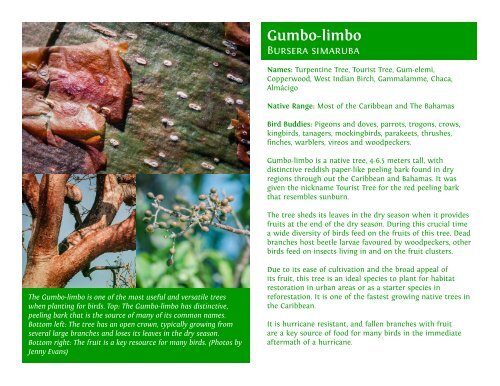Create successful ePaper yourself
Turn your PDF publications into a flip-book with our unique Google optimized e-Paper software.
Gumbo-limbo<br />
Bursera simaruba<br />
Names: Turpent<strong>in</strong>e Tree, Tourist Tree, Gum-elemi,<br />
Copperwood, West Indian Birch, Gammalamme, Chaca,<br />
Almácigo<br />
<strong>Native</strong> Range: Most of <strong>the</strong> <strong>Caribbean</strong> <strong>and</strong> The Bahamas<br />
Bird Buddies: Pigeons <strong>and</strong> doves, parrots, trogons, crows,<br />
k<strong>in</strong>gbirds, tanagers, mock<strong>in</strong>gbirds, parakeets, thrushes,<br />
f<strong>in</strong>ches, warblers, vireos <strong>and</strong> woodpeckers.<br />
Gumbo-limbo is a native tree, 4-6.5 meters tall, with<br />
dist<strong>in</strong>ctive reddish paper-like peel<strong>in</strong>g bark found <strong>in</strong> dry<br />
regions through out <strong>the</strong> <strong>Caribbean</strong> <strong>and</strong> Bahamas. It was<br />
given <strong>the</strong> nickname Tourist Tree <strong>for</strong> <strong>the</strong> red peel<strong>in</strong>g bark<br />
that resembles sunburn.<br />
The tree sheds its leaves <strong>in</strong> <strong>the</strong> dry season when it provides<br />
fruits at <strong>the</strong> end of <strong>the</strong> dry season. Dur<strong>in</strong>g this crucial time<br />
a wide diversity of birds feed on <strong>the</strong> fruits of this tree. Dead<br />
branches host beetle larvae favoured by woodpeckers, o<strong>the</strong>r<br />
birds feed on <strong>in</strong>sects liv<strong>in</strong>g <strong>in</strong> <strong>and</strong> on <strong>the</strong> fruit clusters.<br />
The Gumbo-limbo is one of <strong>the</strong> most useful <strong>and</strong> versatile trees<br />
when plant<strong>in</strong>g <strong>for</strong> birds. Top: The Gumbo-limbo has dist<strong>in</strong>ctive,<br />
peel<strong>in</strong>g bark that is <strong>the</strong> source of many of its common names.<br />
Bottom left: The tree has an open crown, typically grow<strong>in</strong>g from<br />
several large branches <strong>and</strong> loses its leaves <strong>in</strong> <strong>the</strong> dry season.<br />
Bottom right: The fruit is a key resource <strong>for</strong> many birds. (Photos by<br />
Jenny Evans)<br />
Due to its ease of cultivation <strong>and</strong> <strong>the</strong> broad appeal of<br />
its fruit, this tree is an ideal species to plant <strong>for</strong> habitat<br />
restoration <strong>in</strong> urban areas or as a starter species <strong>in</strong><br />
re<strong>for</strong>estation. It is one of <strong>the</strong> fastest grow<strong>in</strong>g native trees <strong>in</strong><br />
<strong>the</strong> <strong>Caribbean</strong>.<br />
It is hurricane resistant, <strong>and</strong> fallen branches with fruit<br />
are a key source of food <strong>for</strong> many birds <strong>in</strong> <strong>the</strong> immediate<br />
aftermath of a hurricane.

















